From
my vantage point, I scrutinize the usual suspects. Ring-necked
ducks with their telltale white “spur” and green-winged
teal with their buffy rump streaks loaf along the edges of
the wetlands. Some mallards engage in aggressive mating behavior
by chasing competitors away from prospective mates, while
others doze in the comfort of the morning sun. A small group
of wood ducks preen themselves, unconcerned with the activity
around them. Dark American coots strut through my view, seemingly
propelling themselves forward by their jutting head movements.
But it is the loner floating along the edge of the bulrush
that catches my attention.
The bird’s drab tawny-brown plumage is unremarkable compared to
the colors flashed by the ring-necks and mallards. The bird is a bit
smaller than the teal, but has a stouter bill that is white and wrapped
with a black band towards the tip. With a sudden lunge forward, the bird
is gone beneath the surface; barely a ripple betrays its presence.
Though one might confuse this bird with some of the diving ducks scattered
across the pond, it is an unrelated species that shares this aquatic
habitat. This bird is a member of the Grebe Family, of which there are
7 North American species.
Characteristics of the family are lobed toes with partial webbing between
the toes (versus the webbed foot of a duck), generally slender bills
with sawlike teeth along the edges, and legs set to the rear of the body.
Though they tend to be weak fliers, these birds do migrate.
This particular species is the pied-billed grebe, named after its variegated
or two-colored bill, but these birds are also known as “dabchicks” and “hell-divers”.
Dabchick refers to the quick diving behavior while the hell-diver name
originates from the bird’s ability to compress air out of their
body cavity and between their feathers. This enables the bird to submerge
like a submarine. At times, only the upper portion of their neck and
head protrude above the water’s surface, and this behavior was
once thought to have a “demonic” association.
Watching the activity of the bird, I can not see any fiendish indication
from its behavior. The sporadic dives that the bird engages in are associated
with feeding, as it searches for prey. Aquatic invertebrates, fish, crustaceans,
tadpoles, frogs, and aquatic plants comprise the diet of the pied-billed.
Studies of stomach contents reveal that these birds ingest a lot of feathers,
presumably to coat the sharp edges of fish spines or frog parts, rather
than for any nutritional value.
Pied-billed grebes spend the majority of their time on the water unlike
the mallards that may forage in the uplands surrounding this marsh. When
on land, grebes appear to have a difficult time walking because their
legs are set very far back beneath their bodies. They seem ready to topple
over, and because of this awkwardness, rarely spend much time away from
their watery worlds. Larger relatives of the pied-billed, the Western
and Clark’s grebes, are incapable of walking and it would take
a modern miracle in structural engineering to enable them to stroll along
the marsh’s edge.
This inability to walk on land should not be confused with the bird’s
running start when they are ready to take to flight.
Grebes need a fairly long runway to get airborne, but constant wing-flapping
compliments their running. Sometimes these birds mistake a rain-slickened
roadway for a stream, but the birds can not lift off of the pavement
because of the lack of the water’s buoyancy.
But this individual doesn’t have those concerns as the marsh has
a good water level. The water inundates the thickets of bulrush and cattails,
perfect locations for the grebe to construct its floating nest. Constructed
of plant material woven together, the nest is anchored to submerged vegetation
or to the bottom of the pond. Though they nest in sloughs or stagnant
ponds, the birds don’t have to worry about their nests being washed
away; however, they also don’t want it to be moved by the wind.
Since it is still early in the season, I don’t think this bird
has an active nest. In another month, maybe, as the breeding season extends
from March through September. At that time both parents will share in
the incubation and chick-rearing, even to the point of giving their young
a ride on the parent’s back. I’m surprised this piggyback
behavior doesn’t translate into another common name for this reclusive,
but widespread species. |
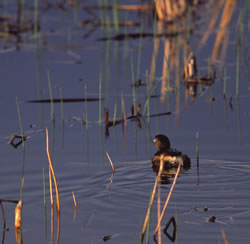
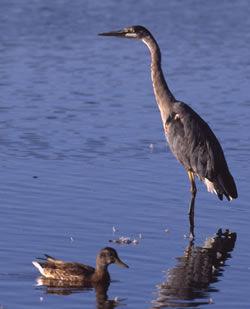
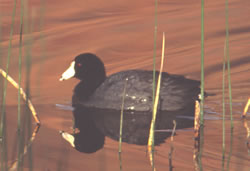
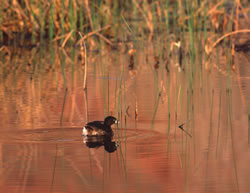
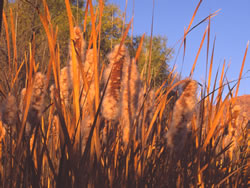
|





